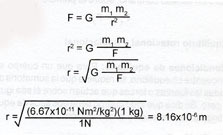Example of the Law of Universal Gravitation
Physics / / November 13, 2021
The force of attraction between two bodies separated by a distance is proportional to the product of these masses and inversely proportional to the square of the distance.
m1= kg
m = kg
r = m
G = 6.67 x 10-11 Nm2 / kg2
F = N
F = G (m1m2/ r2)
EXAMPLE OF THE PROBLEM OF THE LAW OF UNIVERSAL GRAVITATION:
Find the distance at which two masses of one kilogram each must be placed so that they attract each other with a force of 1 N.
F = 1N
G = 6.67 x10-11 Nm2/kg2
m1= 1kg
m2= 1kg
r =?
Impulse: It is the force exerted for the duration in which said force acts.
l = N / s
t = s
F = N
EXAMPLE:
Calculate the momentum required by a particle with a mass of one kg carrying a constant acceleration of 5 m / s2 in 20 s.
l = ft = mat = (1kg) (5m / s2) (20s) = 100 N / s
Amount of linear motion: It is the product of the mass and the speed of the mobile.
P = kgm / s P = mv
m = kg
v = m / s
EXAMPLE:
On a body of mass of 2 kg a constant force is applied during 10 s, producing a change of velocity from 10 m / s to 30 m / s. What force was applied to produce this effect?
To solve this problem, we must take as a basis the formula for momentum and momentum in relation to 2nd. Newton law.
l = Ft = P = mv
Since t, m and the change in velocity are known, we have:
Ft = m (vf-vi)
F (10s) = 2kg (30m / s-10m / s)
F = 2kg (20m / s) / 10s = 4N
Principle of conservation of momentum: It is determined by the relation that when two mobiles collide, the momentum of the sum of the two will not vary, that is, their total momentum is constant.
m1or1 + m2 or2 = m1 v1 + m2v2
mu = amount of movement before impact.
mv = amount of movement after impact.



